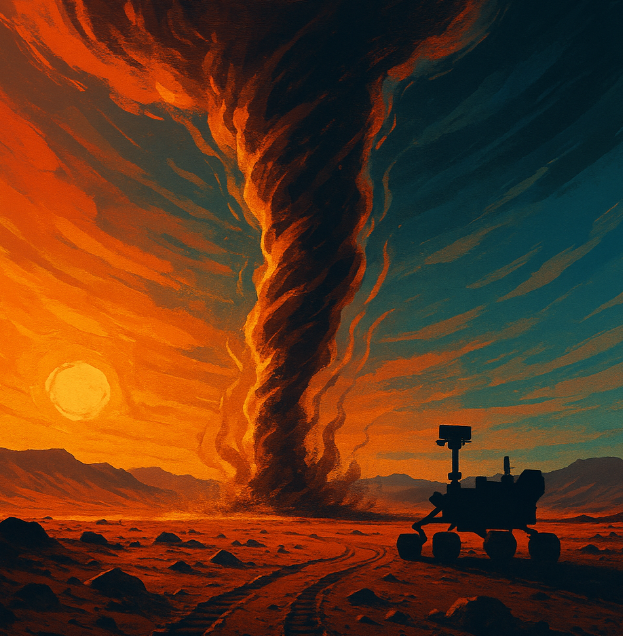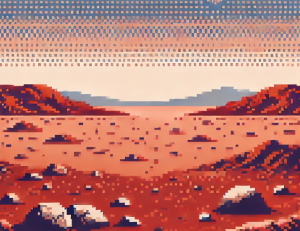
Strong, Fast, and Everywhere: The New Story of Martian Winds
Most Mars weather models are too calm. But a new analysis shows fast, ground-hugging winds on Mars are common—often strong enough to lift dust and shape climate.
If you work in a field station in Rajasthan, a clinic in Lagos, or a teaching lab in Manaus, you know wind changes what you see and what you can do. Mars is no different—only thinner air, colder nights, and a lot more dust. But here’s where it gets interesting…
A simple story with a twist
For years, scientists thought Mars’ near-surface winds rarely got strong enough to kick sand and dust into the air. Models said the “push” from the air—what physicists call wind stress—usually sat below the threshold needed to make grains hop (saltate) and knock finer dust loose.
Contrast framing: We thought X (winds are usually too weak)… but the data say Y (strong near-surface winds are abundant).
How do we know? Researchers used deep learning to scan two decades of orbital images and track more than a thousand dust devils—those spinning columns of air that act like flags for the background wind. They measured how fast and which way these columns moved, across seasons and times of day, all over the planet. Then they translated speeds into wind stress at the surface.
Result: In many places and times, the stresses were higher than global models predict, often crossing the threshold needed to launch sand and inject dust into the atmosphere. And that changes the Mars weather story.
Local vignettes: Why this matters on Earth—and Mars
- India (Thar Desert mindset): If you’ve seen a dust devil racing across dry fields at noon, you’ve already felt the physics. On Mars, dust devils peak from late morning to early afternoon too. That timing aligns with surface heating—strong sun, rising air, and gustier near-ground winds.
- Nigeria (Lagos logistics): On a day when wind and dust slow traffic, you plan around it. Mission teams on Mars need the same mindset: dust in the air dims sunlight, robs solar panels of power, and complicates remote sensing. Knowing when and where strong winds occur helps plan tasks and protect hardware.
- Brazil (Manaus to the dunes of Lençóis): Sand moves when gusts pass a threshold, then keeps going in bursts. The study shows Mars regularly hits those bursts—sometimes over 40 m/s (~90 mph). Even the “average fast” cases around 20–25 m/s (~45–55 mph) are enough to start sand hopping and loft fine dust.
How the team cracked it
The researchers trained detectors to spot dust devils in images from ESA’s Trace Gas Orbiter (CaSSIS) and Mars Express (HRSC). Two clever tricks made the measurements possible:
- Stereo pairs: Two images taken seconds apart let you see how far a dust devil moved, like a stop-motion clip.
- Color “fringes”: Moving columns create tiny color offsets between channels; measure the offset, get the speed.
With this, they built a global, seasonal, and daily map of dust-devil migration over 10+ Mars years. The big picture: speeds often exceed what the Mars Climate Database (a leading global model) expects near the ground, especially around midday and in known dust-source regions. In some hotspots, fast-moving dust devils lined up in space and time with larger dust-lifting events and storms.
What the numbers really say (without the jargon)
- Timing: First dust devils show up around 8 a.m., last ones near 5 p.m., with a noon–early afternoon peak.
- Strength: Many events pass the dust-lifting threshold. A good chunk hit stresses high enough to move 100-micron sand, which in turn knocks finer dust into the air.
- Speed: Typical values cluster around 10–20 m/s, but peaks reach ~44 m/s.
- Models vs reality: Global models systematically underestimate these near-surface winds by several meters per second. That gap matters for climate, storm onset, and operations.
Why it matters for science, missions, and future crews
Better weather and climate models. If the low-level winds are stronger and more frequent than expected, they likely explain why Mars moves so much sand and dust despite the thin air. Updating models with these observations can improve storm forecasts, thermal predictions, and climate cycles.
Safer, smarter operations. Landers and rovers live or die by power. Strong winds can both clean solar panels (good!) and coat them with new dust (bad!). Knowing when fast winds tend to arrive—by season and local time—helps schedule activities and plan for power dips.
Human exploration. For future astronauts, dust is a health, safety, and logistics issue. Better maps of wind strength and direction help site habitats, place antennas, and set EVAs (spacewalks) to avoid risky hours. Think of it as the first draft of a Mars marine forecast: winds, chop, and visibility for the red ocean of dust.
A humble method with big reach
What makes this study powerful is its simplicity and scale: use dust devils as moving tracers, measure their drift, and infer the winds that push them. The team didn’t need new sensors—just careful image alignment, well-trained models, and lots of patient checking.
It’s a reminder to every early-career scientist: the clever use of existing data can overturn assumptions. You don’t always need a bigger telescope or a new rover. Sometimes you need a sharper question and a better way to read the pictures you already have.
The bottom line
Mars is windier—near the ground—than our models admit. Those overlooked gusts help feed the atmosphere with dust, shape dunes, and set the stage for storms. Building them into forecasts won’t just satisfy climate modelers; it will keep robots working longer and make human missions safer.
Let’s Explore Together
- Could this approach—using simple tracers to map winds—work in your field site or lab? What would you track?
- If you were on this team, what would you test next: storm prediction, panel-cleaning forecasts, or landing-site wind maps?
- What everyday problem—on Earth or on Mars—do you wish science could solve with the data we already have?



